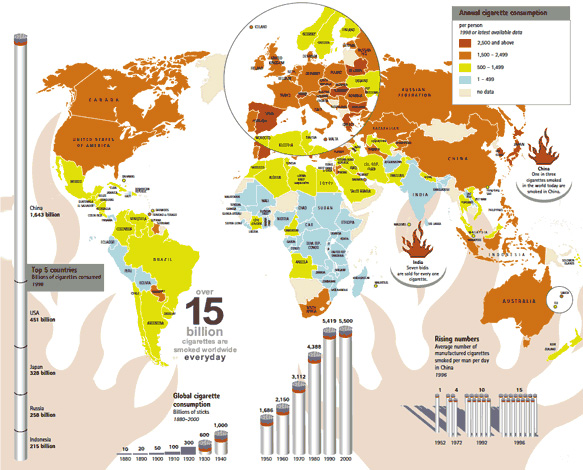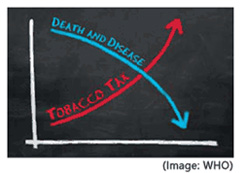
|
Prevention
|
Tobacco Control
APHN ARCHING GOAL

Tobacco Facts
Asia has the highest number of tobacco users and is the prime target of multi-national global tobacco companies. The Western pacific region, comprising Asia and the Eastern Pacific, has the world’s highest tobacco use rates, and two-thirds of all men using tobacco. Some of the world’s highest smoking rates can be found in the Asia-Pacific region, with 2.3million deaths from disease caused by tobacco smoking each year, almost half of the 5million global tobacco deaths each year.
- One person dies every 6 seconds from a tobacco-related disease. 100 million people died from tobacco-related diseases in the 20th century. Without action taken, 1 billion people could die this century from tobacco-related diseases.
- Tobacco use costs the world an estimated $500 billion each year in health care expenditures, productivity losses, fire damage and other costs.
- Health care costs associated with tobacco related illnesses are extremely high. In the United States, annual tobacco-related health care costs amount to 96 billion USD; in Germany, 7 billion USD; in Australia, 1 billion USD.
- Tobacco-related illnesses and premature mortality impose high productivity costs to the economy because of sick workers and those who die prematurely during their working years. Lost economic opportunities in highly-populated developing countries will be particularly severe as tobacco use is high and growing in those areas.
- Countries that are net importers of tobacco leaf and tobacco products lose millions of dollars a year in foreign exchanges.
- Fire damage and the related costs are significant. In 2000, about 300,000 or 10 percent of all fire deaths worldwide were caused by smoking and the estimated total cost of fires caused by smoking was 27 billion USD.
- Tobacco production and use damage the environment and divert agricultural land that could be used to grow food.
(Reference: WHO)
For More Facts on Tobacco Globally
|
Tobacco Facts in Asia
|
Tobacco Consumption
 (Reference: Tobacco Consumption Map from Tobacco Atlas) |
|
Tobacco & CVDAccording to the World Health Organization, CVDs are the number 1 cause of death globally: more people die annually from CVDs than from any other cause. An estimated 17.5 million people died from CVDs in 2012, representing 31% of all global deaths. Of these deaths, an estimated 7.4 million were due to coronary heart disease and 6.7 million were due to stroke. Smoking is estimated to cause nearly 10 per cent of CVD, and is the second leading cause of CVD, after high blood pressure.
|
Factsheet on Tobacco and CVD
(Reference: WHF “Tobacco: the totally avoidable risk factor of cardiovascular disease” ) Health Benefits: See what happens when you stop smoking … (Read more) |
Women & Tobacco
|
|
More Links on Women & Tobacco
|
There are approximately 200 million women in the world who smoke, and in addition, there are millions more who chew tobacco. Every year, 1.5 million women die from tobacco use. Since many smokers are quitting smoking or die from tobacco-related diseases, the tobacco industry tries to attract new generations to consume tobacco.
As a result, they are targeting a market such as women and children.
(Reference: WHO)
- About 200 million of the world’s one billion smokers are women
- As many girls as boys now smoke in some countries
Boys and girls start using tobacco for different reasons - Every year, 1/5 million women die from tobacco use
- Women are one of the biggest targets of the tobacco industry
- More women than men smoke “light” cigarettes
Tobacco use harms women differently from men - Women constitute 64% of deaths from second-hand smoke
- People who smoke should avoid exposing them people with whom they live & work to second-hand smoke
- Controlling tobacco use among women is an important part of any tobacco control strategy
(Reference: WHO Gender and Tobacco) For Full Version
Youth/Children & TobaccoEvery day, 80,000 to 100,000 young people around the world become addicted to tobacco.If current trends continue, 250 million children and young people alive today will die from tobacco-related diseases. (Reference: WHO)
|
How Youth are Targeted by Tobacco Industries — Youth Prevention EffortsThe tobacco industry created youth smoking-prevention programs in the 1980s due to increasing public scrutiny. The industry’s main goal, however, was not to prevent youth smoking, but rather to counter growing concerns over their marketing practices aimed at youth. As outlined in tobacco industry documents, prevention programs were actually created to prevent further tobacco regulations, enhance the industry’s public image and build key relationships with legislators, educators and other influential parties. While the tobacco industry’s prevention ads give the impression of warning against youth smoking, their carefully crafted themes actually deliver mixed messages to youth. Messages often include reminding youth that smoking is for adults and stressing the “law” as the reason not to smoke. Consider Lorillard’s campaign that claims, “Tobacco is whacko…if you’re a teen.” In other words, smoking is okay if you’re an adult. (Reference: Campaign for Tobacco Free Kids, “Big Surprise: Tobacco Company Prevention Campaigns Don’t Work; 2012) |
LinksThe Tobacco Atlas : Smoking Among Youth |
Secondhand Smoke & Harm on Heart Health
Each year, exposure to secondhand smoke kills 600,000 people: 28 per cent of them are children. Of all adult deaths caused by secondhand smoke, more than 80 per cent are from CVD. (Öberg M, et al, Global estimate of the burden of disease from second-hand smoke. Lancet. 2010)
|
Facts on Secondhand Smoke and Related to CVD
|
Additives in Tobacco
 |
Tobacco smoke is made up of more than 7,000 chemicals, including over 70 are carcinogens. There is no safe way to use tobacco whether it is cigarettes, cigars, pipes and spit and other types of smokeless tobacco.
Click here to see the list of Chemicals in Cigarettes
|
Tobacco Control
The tobacco epidemic is preventable: The tobacco epidemic is man-made and entirely preventable. Yet, only half of the world’s population lives in a country that fully protects its people with at least one of the key policy interventions that significantly reduce tobacco use.
The World Health Organization developed the Framework Convention on Tobacco Control (FCTC) in response to the globalization of the tobacco epidemic. The spread of the tobacco epidemic is facilitated through a variety of complex factors with cross-border effects, including trade liberalization and direct foreign investment. Other factors such as global marketing, transnational tobacco advertising, promotion and sponsorship, and the international movement of contraband and counterfeit cigarettes have also contributed to the explosive increase in tobacco use.
For FCTC Full Version
Global Tobacco Epidemic
The tobacco epidemic kills nearly 6 million people a year
This includes more than 600 000 nonsmokers who will die from exposure to tobacco smoke. They die from cancer, heart disease, asthma and other illnesses. Unchecked, that number will increase to more than eight million a year by 2030. Tobacco use is a risk factor for six of the eight leading causes of deaths in the world.
Over 80% of tobacco deaths will occur in the developing world
Tragically, the epidemic is shifting towards the developing world, where more than 80% of tobacco-related deaths will occur within a few decades. The shift is caused by a global tobacco industry marketing strategy that targets young people and adults in developing countries. In addition, because most women currently do not use tobacco, the tobacco industry aggressively reaches out to them to tap into this potential new market.
Total economic loss is estimated approx. US$12.7 trillion over the next 20 year.
Given current estimates of the burden of tobacco-related disease, researchers predict that tobacco use will kill one billion people this century with a potential total economic loss of about US$12.7 trillion over the next 20 years, or 1.3% of global GDP annually.
Signatories to the WHO FCTC as of 2015: 168Parties to the WHO FCTC: 180 (Last Party: Zimbabwe. Entry into force: 4 March 2015) |
Global Tobacco Epidemic (by WHO) |
 |
What is MPOWER?
MPOWER is the six measurements to assist in the country-level implementation of effective interventions to reduce the demand for tobacco. M = Monitor tobacco use and prevention policies |
Tobacco Control & Tobacco Industry
The primary goal of tobacco control is to prevent tobacco-caused disease and death. On the other hand, as “business”, tobacco companies seek to maximize its profit and uptake of tobacco use. The prime targets of tobacco industries are young people and women, as well as developing countries, and the tobacco industry’s tactful marketing strategies are to continue to counter the efforts of the tobacco control and to promote tobacco use. Here are some of the facts on tobacco control and the claim of the tobacco companies:
| Myth: Tobacco control will result in permanent job losses for an economy.
Reality: Successful control policies will lead to only a slow decline in global tobacco use (which is projected to stay high for the next several decades). The resulting need for downsizing will be far less dramatic than many other industries have had to face. Furthermore, money not spent on tobacco will be spent on other goods, generating alternative employment. Studies for this report show that most countries would see no net job losses and that a few would see net gains if consumption fell. Myth: Governments should not discourage smoking other than making its risks widely known. Otherwise, they would interfere with consumers’ freedom of choice. Reality: First, many smokers are unaware of their risks, or they simply underestimate or minimize the personal relevance of those risks, even in high-income societies where the risks are relatively widely known. Second, most smokers start when they are children or adolescents — when they have incomplete information about the risks of tobacco and its addictive nature — and by the time they try to quit, many are addicted. Third, smoking imposes costs on non-smokers. For these reasons, the choice to smoke may differ from the choice to buy other consumer goods and governments may consider interventions justified. Myth: Smokers always bear the costs of their consumption choices. Reality: Not necessarily so. They do impose certain costs on non-smokers. The evident costs include health damage, nuisance and irritation from exposure to environmental tobacco smoke. In addition, smokers may impose financial costs on others (such as bearing a portion of smokers’ excess healthcare costs) . However, the scope of these costs is difficult to measure and they vary in place and time, so this report makes no attempt to quantify them In high-income countries, smokers’ healthcare costs on average exceed non-smokers’ in any given year. It has been argued that, because smokers tend to die earlier than nonsmokers, their lifetime health care costs may be no greater than those of nonsmokers; however, recent reviews in high-income nations conclude that smokers’ lifetime healthcare costs do indeed exceed nonsmokers’, despite their shorter lives. If healthcare is paid for to some extent by the public sector, smokers will thus impose their costs on others. |
More Information on Tobacco control & Tobacco Industry Interference
|
Useful Tobacco Control Related Links
|
Tobacco Taxation
– The Best Win-Win Policy –
|
According to WHO, Increasing tobacco taxes by 10% generally decreases tobacco consumption by 4% in high-income countries and by about 8% in low- and middle-income countries. A 70% increase in the price of tobacco would prevent up to a quarter of all tobacco-related deaths among today’s smokers.
At the 2015 World Conference on Tobacco and Health in Abu Dhabi, the UNION announced: “Currently just 8% of the world’s population lived in countries with sufficiently high tobacco taxes; therefore there is great scope for focusing tax to reduce tobacco consumption globally. And in many countries cigarette prices have not kept up with inflation, or the price increases of other goods and services. Tripling tobacco taxes worldwide would increase tobacco prices by 70% and would prevent 115 million tobacco-related deaths by 2050. The most lives saved would be young men in low- and middle-income countries. (Reference: The UNION. Full Version) |
Raising Tobacco Taxes is a Win-Win Solution
Higher tobacco taxes will …
(1) Higher tobacco taxes will decrease tobacco consumption
Increasing tobacco taxes has a greater impact on consumption in low- and middle-income countries. A price rise of 10% decreases consumption by up to 8% in low- and middle- income countries and by 4% in high-income countries. It is estimated that a tripling of excise tax on tobacco in most low- and middle-income countries will double cigarette prices, reducing consumption by approx. 40 %.
Example: Egypt increased tax in 2010 which led to a decrease in sales by 14% in 2 years
(Reference: WHO 2014. Document number WHO/NMH/PND/14.2)
(2) Higher tobacco taxes will save lives & help young & poor.
Increasing tobacco taxes will discourage smokers and ex-smokers to buy tobacco products, as well as for people to start smoking. By smokers to stop smoking will not only help to improve their health but also lessen secondhand smoke exposure to their family and co-workers.
Health Benefits: See what happens when you stop smoking … (Read more)
(3) Higher tobacco tax will increase government revenue
According to the World Bank, calculations show that even very substantial cigarette tax increases will still reduce consumption and increase tax revenues. This is in part because the proportionate reduction in demand does not match the proportionate size of the tax increase, since addicted consumers respond relatively slowly to price rises. Furthermore, some of the money saved by quitters will be spent on other goods which are also taxed. Historically, raising tobacco taxes, no matter how large the increase, has never once led to a decrease in cigarette tax revenues.
WHO Publication on Tobacco Tax & Government Revenue
|
Tobacco Control Health Programs are Under FundedGovernments collect nearly US$133 billion in tobacco tax revenue each year, but spend less than US$1 billion on tobacco control, the WHO Report on the Global Tobacco Epidemic, 2011. To read more… In low- and middle-income countries and tobacco control programs or health programs are underfunded. Good monitoring tracks the extent and character of the tobacco epidemic and indicates how best to tailor policies. Such a tax system will have the greatest public health impact, while at the same time produce a more stable, reliable stream of tax revenues. It will be most effective when combined with strong tax administration, including the use of a state-of-the art monitoring, tracking and tracing system that includes high-tech tax stamps and licensing of all involved in the production and distribution of tobacco products. Paper on Sustainable Funding Models for Tobacco Control by the UNION |
Where Do We Start?
In 2014, APHN released a Tobacco Taxation Toolkit, to help Tobacco Control Advocacy in the region to raise tobacco tax. This kit comprises an action plan, fact sheet, draft letter and links to further resources. Work with existing country tobacco control alliances and, where appropriate, work together on a tobacco tax campaign.
Step 1
Check your country profile and check progress on tobacco taxation (Click here)
Step 2
Check with your government (Health Department or Finance Department/Treasury) to get latest information on tax policies and proposals.
Step 3
Contact your national tobacco control NGOs to outline your enthusiasm for getting involved in a tobacco tax campaign and align strategies – ie Joint letter/submission.
Step 4
Prepare and send letter to key players and decision –makers – eg Finance Minister, Health Minister, Treasury/Finance Department Officials, Health Department Officials.
Step 5
Arrange a meeting with key players – eg Finance Minister, Health Minister, Treasury/ Finance Department Officials, Health Department Officials.
Step 6
Prepare media release and/or letter-to-the-editor to the media.
Step 7
Monitor and report progress to APHN/APSC.
(APHN Tobacco Taxation Campaign – Full Version)



